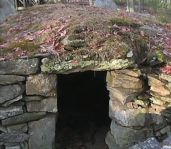|
by Salvatore Michael Trento  Innovative theoretical approach to places of mystery
Innovative theoretical approach to places of mystery
Salvatore M. Trento's works have revolutionary implications for the study of sacred sites. His theoretical approach is based on the idea that electromagnetic fields may influence the brain, and that many sites where inscriptions, standing stones, and stone chambers were located had aberrant magnetic fields. Trento hypothesizes that the "extreme geomagnetic flux associated with these locales" may stimulate "a cascade of pineal gland chemicals that altered cognition." Certainly the readings that Trento took at the sites presented in this book support this idea: they suggest that the locations of cave paintings and sacred sites were chosen as a result of these geomagnetic influences. His observations may have applications not only to the study of sacred sites such as are featured in this book, but paranormal phenomena such as UFOs, ghosts, and Mothman. I think that Trento, famed outer limits researcher John Keel, and anomalist Jim Brandon should all get together to see if they can come up with a grand unified theory of paranormal phenomena. In connection with his idea that prior civilizations were more in touch with nature than we are, Trento reminds us that many of these places are sacred, and that we need to listen to them. They may have the keys to our continued survival on this planet. The guide thus becomes a means to once again restore our lost union with the earth: "To heal the spirit, if not the body," he writes, "we need to reconnect with our surroundings in ways that go beyond Earth Day celebrations and tree hugging. We must learn to feel what the planet is offering. But to do that we need to experience it firsthand." This book, then, reminds us, as did Emerson, that revelation is available to us all, and that "the sun shines today also," as it did for our ancestors. Perhaps it is not the sun shining that affects us, but rather geomagnetic forces flowing and ebbing. This is not, I admit, as poetic as Emerson's ideas, but it may be at the heart of our religious experiences in nature, and may indeed offer us a solution to the current ecological crisis. Other places featured in this book are of interest not because of their impact upon the pineal gland or other biochemical systems, but merely because of their strangeness or grandeur: the fossil beds at Lompoc; the Calico Early Man site, which some say provides evidence that humanity was present in the Americas as early as 200,000 years ago; the locations of Bigfoot and sea serpent sightings; the pirate treasure of Neahkahnie Beach; the Sausalito Hum. My personal favorite is the Lava Beds National Monument, whose beauty and grandeur cannot be understated. Though the variety of topics found in this book might seem scattershot in its approach, in fact there are sufficient destinations here to satisfy a carful of people: anthropologists, archeologists, paleontologists, biologists and paranormalists alike. My wife Fayaway and I have used this guide for years, and can vouch for the information contained herein: directions are clear, as are the maps, and contact information is included for some sites. This guide is recommended for those travellers in pursuit of the strange, the marvelous, and the strange in the Pacific Coast states. Happy travelling! |

